Latest Thread Images
Featured Sponsor Listings
You are using an out of date browser. It may not display this or other websites correctly.
You should upgrade or use an alternative browser.
You should upgrade or use an alternative browser.
The RMAA (RightMark Audio Analyzer) Source and Audio Device Measurement Thread [Overview of Measurements in Post #3, Tutorial in Post #2]
- Thread starter HiFiChris
- Start date
yuriv
100+ Head-Fier
- Joined
- Apr 30, 2008
- Posts
- 156
- Likes
- 270

I picked up a Radsone EarStudio ES100 Bluetooth receiver because it gives my mobile devices a system-wide equalizer. Its iOS or Android apps can create EQ presets, and they can be applied to any paired Bluetooth device or USB-connected PC or Mac. For me it's the ES100’s most useful feature—really my only reason for picking one up. Unfortunately, firmware version 1.2.1 has only a 10-band graphic equalizer. A 5-band parametric EQ would have been better. Oh well, maybe a future update will have it.
Here are a few RMAA measurements of its EQ in action:

-6 dB at 31.5 Hz, 1 kHz, and 16 kHz
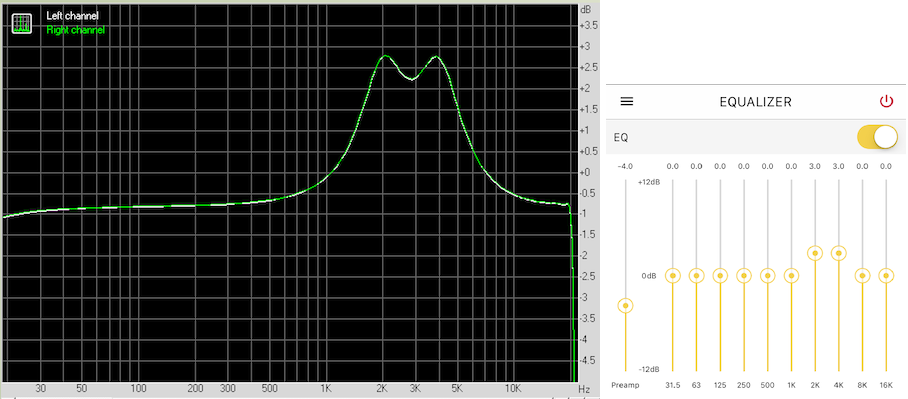
+3 dB at 2 kHz, 4kHz
It’s not a parametric EQ so you won’t be able to dial in the precise frequency and get a high enough Q to be able to cancel narrow resonances. Coarse adjustments like bass boost or reduction are possible. For example, here’s what it can do for a cheap (but good) IEM, the $6 Sony MH755:

Here’s what RMAA measures for the bass reducer part of this EQ:

If the ES100 had a parametric EQ instead, it would need only one (maybe two) of its biquad filters to do something similar. And the result would be smoother and take less DSP resources.
I wasn’t completely successful with the LG Quadbeat 3 or the original Quadbeat. I prefer the EQ’ed results though:

LG Quadbeat 3 (AKG tuned version), with and without ES100 EQ
The goal was to reduce the bass and the level of the peak at 4.5 kHz. Even If you could get a consistent insertion depth, the EQ is not fine enough to handle the narrow peak.

LG Quadbeat HSS-F220, with and without ES100 EQ
The main goal was to reduce the lower midrange thickness. It somewhat worked.
I’m really hoping a future update will include a parametric EQ, as it’s the one feature that can really improve the sound quality.
As for its audio performance, Radsone provides measurements of the ES100 online:
I made some basic tests with RMAA 6.4.4 just to make sure the unit I received isn’t malfunctioning. TL; DR version: probably not. Here are the boring details:
After installing the Windows 10 April 2018 update, my Surface and Thinkpad now crash when I plug in my E-mu 0404USB. So, I borrowed a Focusrite Forte from my Mac Pro for these measurements.
The EarStudio ES100 is a USB Audio class 1.0 device, which is limited to 16-bit, 48-kHz playback. The option to change to any other format in Windows is grayed out. Here are some RMAA measurements of playback in Windows with the Focusrite Forte's line inputs as the load:

From left to right, 1644 Sharp Roll-Off filter, 1644 slow Roll-Off filter, 1648 Sharp Roll-Off filter, 1648 slow Roll-Off filter
For these measurements, the EarStudio ES100’s analog volume was set to 0 dB, the digital source volume was at 0 dB, DCT was off, and crossfeed was off. With these settings, a full-scale 1 kHz sine wave is about 910 mV rms.

Top: Frequency response, sharp roll-off and slow roll-off filters
Middle: 1 kHz + harmonic distortion
Bottom: Intermodulation distortion
Now for the same settings, but with a 16-ohm load on each channel:

From left to right, 1644, 1648 results.

Top: 1 kHz + harmonic distortion, both channels with 16-ohm load
Bottom: Intermodulation distortion, both channels with 16-ohm load
The playback into 16 ohms is pretty clean. A full-scale sine doesn’t clip with the ES100 analog volume at 0 dB. The ES100 can produce a higher-voltage signal—the analog volume goes up to +6 dB, but with lots of clipping on the 0 dBFS sine. See the non-RMAA section later.
The 2.5 mm jack has “balanced” output for double the voltage and double the output impedance. I did not test this feature.
The EarStudio ES100 has a setting called DCT that supposedly “eliminates subtle digital noise inherent in all digital sound sources and restores sound details to provide music with originally intended sound quality.” When listening to music, I didn’t notice much difference with this setting turned on. Here’s what it does to the frequency response:
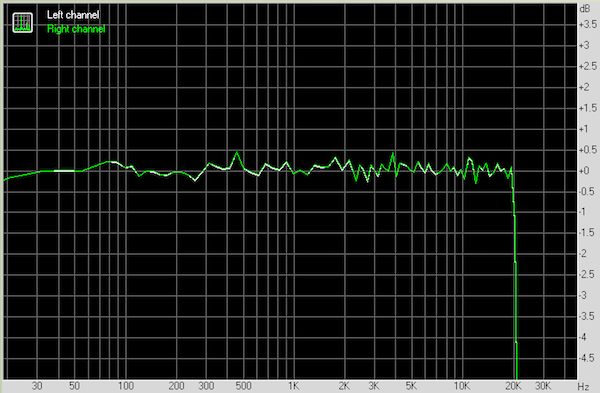
Frequency response with DCT level 5 (out of 10)
The app can also turn on the ES100's crossfeed. Here’s what it looks like in RMAA:

RMAA crosstalk measurements with crossfeed off and on.
It doesn’t look like a Linkwitz crossfeed. See the non-RMAA section for more on this.
Non-RMAA stuff:
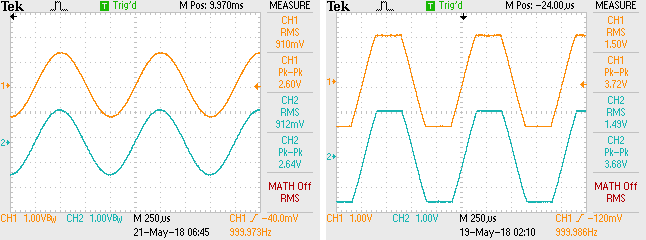
0 dBFS 1 kHz sine, ES100 analog volume at 0 dB and +6 dB
It's well into clipping at + 6dB. The onset of clipping happens somewhere in between:
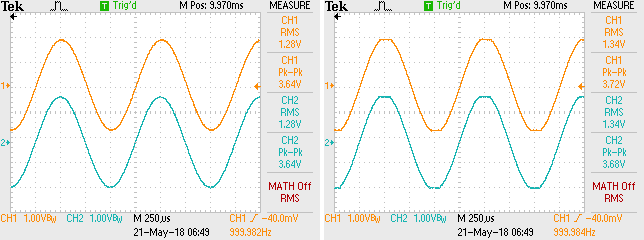
0 dBFS 1 kHz sine, ES100 analog volume at +3 dB and + 3.5 dB
I should have measured the distortion at +3 dB.
With 16-ohms on both channels, clipping happens earlier:

0 dBFS 1 kHz sine, ES100 analog volume at +1.5 dB and + 2.0 dB.
Again, I should have measured the distortion at +1.5 dB.
Of course, you wouldn’t be listening to music this loud on the typical 16-ohm IEM. Here’s what happens with the analog volume control at -6 dB:

1 kHz sine, analog volume at -6 dB, into Focusrite Forte line in (left), into 16-ohm load (right)
From here, we can estimate the output impedance.
The calculation can also be done for the measurements made with the analog volume at 0 dB. The result is similar—a little lower. Radsone claims that it's around 1 ohm.
J-Test
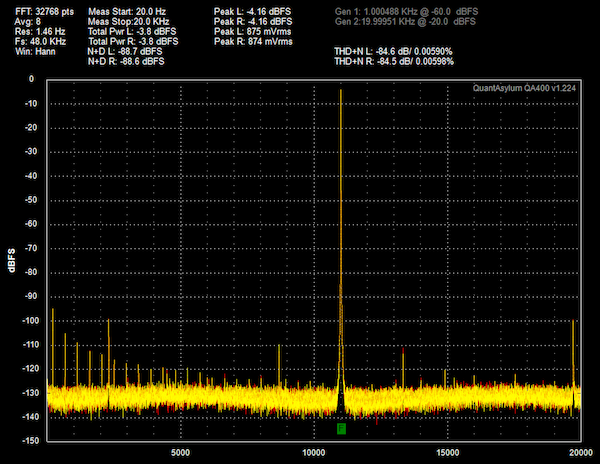
16-bit J-test signal, USB playback
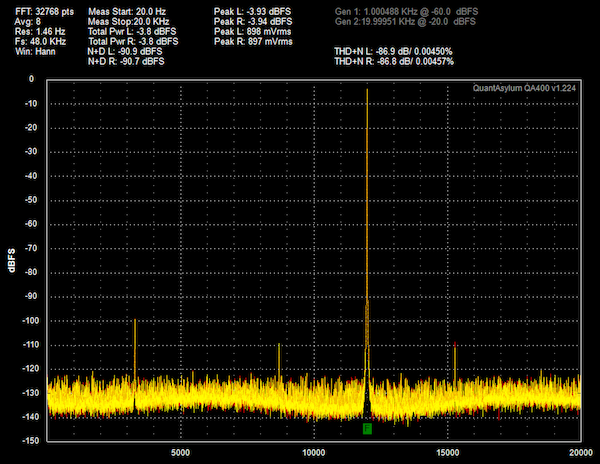
24-bit J-test signal, USB playback
USB is limited to 16-bit playback, and locked at 48 kHz, so we’re probably not seeing data-induced jitter from the 24-bit file. It might as well be a pure 12 kHz sine. I don't have any AptX HD-capable Bluetooth devices, otherwise I would have tested there instead.
Unlike the equalizer, the choice of reconstruction filter doesn’t have much of an audible effect. I don’t know why they prioritized this over something much more useful, like a parametric EQ. Here’s what their impulse responses look like:

Left to right: Sharp Roll-Off filter, Short Delay, Sharp Roll-Off filter
There seems to be a short delay between the channels. Notice that the peaks of the impulses don't line up. The Apple and Google dongles don’t have this inter-channel delay, which can also be seen here:

Edge of 60 Hz square wave (fake step response): Sharp Roll-Off filter (left), Short Delay Sharp Roll-Off filter (right)
The crossfeed is interesting. It looks like they try to implement some sort of ITD. When it plays back a file with an impulse on only channel, the signal on the other channel starts roughly 2.5 ms later:

Left: Impulse on right channel (top trace), crossfeed level 10 signal on left channel (bottom trace). Right: The same, 2.5 ms per division. Note the difference in the vertical scale for the two traces.
So, is 2.5ms x the speed of sound close to whatever it ought to be? You be the judge.
My scope has more noise than the Focusrite Forte, so I recorded on the Forte the crossfeed signal caused by impulses on the other channel. Here’s what a frequency analysis in Adobe Audition and Audacity look like:
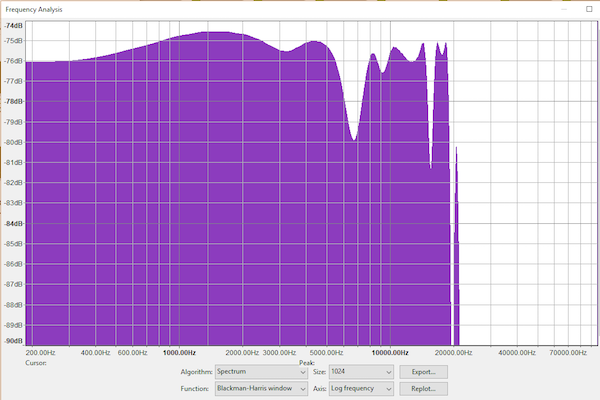
Audacity - frequency analysis of crossfeed signal
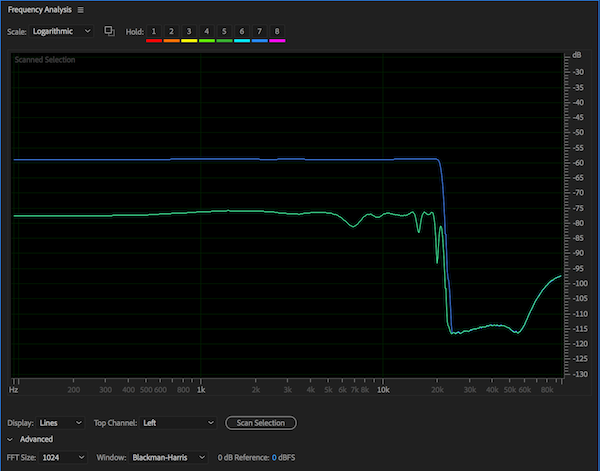
Adobe Audition - frequency analysis of crossfeed signal. Blue: spectrum of recorded impulse on right channel. Green: spectrum of resulting crossfeed signal on left channel.
Finally, a word about the noise level. I simply don't hear any hiss on the ES100 with my usual headphones and IEMs. The noise performance is better than most of my other Bluetooth headphones: Bose QC35, Jaybird Freedom/X3 and Skullcandy Grind wireless all have very soft, but audible hiss. I don’t find their noise offensive and I really don’t notice unless I pay attention. The Bose, in particular, has very little self noise that’s almost always better than the outside noise that it replaces with its noise-cancelling circuitry. My Airpods are pretty much dead silent.
With some UE600vi IEMs, I can easily hear the EarStudio’s hiss when its analog volume is at 0 dB. But nobody will be listening to crazy levels like that with sensitive IEMs. The advantage of the analog volume control is that the background hiss is also attenuated whenever you decrease the volume. With pop music, a good level with the UE600vi is around -36 dB on the analog volume control. With classical, it’s around -27 to -30 dB. There is no noise to be heard whatsoever with this kind of attenuation.

Noise level in dBV, into 16-ohm load on both channels
The EarStudio ES100 is a USB Audio class 1.0 device, which is limited to 16-bit, 48-kHz playback. The option to change to any other format in Windows is grayed out. Here are some RMAA measurements of playback in Windows with the Focusrite Forte's line inputs as the load:

From left to right, 1644 Sharp Roll-Off filter, 1644 slow Roll-Off filter, 1648 Sharp Roll-Off filter, 1648 slow Roll-Off filter
For these measurements, the EarStudio ES100’s analog volume was set to 0 dB, the digital source volume was at 0 dB, DCT was off, and crossfeed was off. With these settings, a full-scale 1 kHz sine wave is about 910 mV rms.

Top: Frequency response, sharp roll-off and slow roll-off filters
Middle: 1 kHz + harmonic distortion
Bottom: Intermodulation distortion
Now for the same settings, but with a 16-ohm load on each channel:

From left to right, 1644, 1648 results.

Top: 1 kHz + harmonic distortion, both channels with 16-ohm load
Bottom: Intermodulation distortion, both channels with 16-ohm load
The playback into 16 ohms is pretty clean. A full-scale sine doesn’t clip with the ES100 analog volume at 0 dB. The ES100 can produce a higher-voltage signal—the analog volume goes up to +6 dB, but with lots of clipping on the 0 dBFS sine. See the non-RMAA section later.
The 2.5 mm jack has “balanced” output for double the voltage and double the output impedance. I did not test this feature.
The EarStudio ES100 has a setting called DCT that supposedly “eliminates subtle digital noise inherent in all digital sound sources and restores sound details to provide music with originally intended sound quality.” When listening to music, I didn’t notice much difference with this setting turned on. Here’s what it does to the frequency response:

Frequency response with DCT level 5 (out of 10)
The app can also turn on the ES100's crossfeed. Here’s what it looks like in RMAA:

RMAA crosstalk measurements with crossfeed off and on.
It doesn’t look like a Linkwitz crossfeed. See the non-RMAA section for more on this.
Non-RMAA stuff:

0 dBFS 1 kHz sine, ES100 analog volume at 0 dB and +6 dB
It's well into clipping at + 6dB. The onset of clipping happens somewhere in between:

0 dBFS 1 kHz sine, ES100 analog volume at +3 dB and + 3.5 dB
I should have measured the distortion at +3 dB.
With 16-ohms on both channels, clipping happens earlier:

0 dBFS 1 kHz sine, ES100 analog volume at +1.5 dB and + 2.0 dB.
Again, I should have measured the distortion at +1.5 dB.
Of course, you wouldn’t be listening to music this loud on the typical 16-ohm IEM. Here’s what happens with the analog volume control at -6 dB:

1 kHz sine, analog volume at -6 dB, into Focusrite Forte line in (left), into 16-ohm load (right)
From here, we can estimate the output impedance.
The calculation can also be done for the measurements made with the analog volume at 0 dB. The result is similar—a little lower. Radsone claims that it's around 1 ohm.
J-Test

16-bit J-test signal, USB playback

24-bit J-test signal, USB playback
USB is limited to 16-bit playback, and locked at 48 kHz, so we’re probably not seeing data-induced jitter from the 24-bit file. It might as well be a pure 12 kHz sine. I don't have any AptX HD-capable Bluetooth devices, otherwise I would have tested there instead.
Unlike the equalizer, the choice of reconstruction filter doesn’t have much of an audible effect. I don’t know why they prioritized this over something much more useful, like a parametric EQ. Here’s what their impulse responses look like:

Left to right: Sharp Roll-Off filter, Short Delay, Sharp Roll-Off filter
There seems to be a short delay between the channels. Notice that the peaks of the impulses don't line up. The Apple and Google dongles don’t have this inter-channel delay, which can also be seen here:

Edge of 60 Hz square wave (fake step response): Sharp Roll-Off filter (left), Short Delay Sharp Roll-Off filter (right)
The crossfeed is interesting. It looks like they try to implement some sort of ITD. When it plays back a file with an impulse on only channel, the signal on the other channel starts roughly 2.5 ms later:

Left: Impulse on right channel (top trace), crossfeed level 10 signal on left channel (bottom trace). Right: The same, 2.5 ms per division. Note the difference in the vertical scale for the two traces.
So, is 2.5ms x the speed of sound close to whatever it ought to be? You be the judge.
My scope has more noise than the Focusrite Forte, so I recorded on the Forte the crossfeed signal caused by impulses on the other channel. Here’s what a frequency analysis in Adobe Audition and Audacity look like:

Audacity - frequency analysis of crossfeed signal

Adobe Audition - frequency analysis of crossfeed signal. Blue: spectrum of recorded impulse on right channel. Green: spectrum of resulting crossfeed signal on left channel.
Finally, a word about the noise level. I simply don't hear any hiss on the ES100 with my usual headphones and IEMs. The noise performance is better than most of my other Bluetooth headphones: Bose QC35, Jaybird Freedom/X3 and Skullcandy Grind wireless all have very soft, but audible hiss. I don’t find their noise offensive and I really don’t notice unless I pay attention. The Bose, in particular, has very little self noise that’s almost always better than the outside noise that it replaces with its noise-cancelling circuitry. My Airpods are pretty much dead silent.
With some UE600vi IEMs, I can easily hear the EarStudio’s hiss when its analog volume is at 0 dB. But nobody will be listening to crazy levels like that with sensitive IEMs. The advantage of the analog volume control is that the background hiss is also attenuated whenever you decrease the volume. With pop music, a good level with the UE600vi is around -36 dB on the analog volume control. With classical, it’s around -27 to -30 dB. There is no noise to be heard whatsoever with this kind of attenuation.

Noise level in dBV, into 16-ohm load on both channels
Edit: Added frequency analysis of crossfeed signal by Adobe Audition, as promised.
Last edited:
reginalb
1000+ Head-Fier
- Joined
- Aug 11, 2011
- Posts
- 1,061
- Likes
- 295
Well, my Merlins are finally fixed after having been stepped on a couple years ago, and I just never got around to having them reshelled. Well, I have, so I can do some measurements again.
HiFiMan 801 (v2 amp module, I believe)
Alright, we all know how this is going to go, but for some reason I really like this absurdly terrible "Hifi" player. It's mainly that it looks like a casette player while actually being an MP3 player which, with Rockbox, is actually not that bad if I'm listening with my Grados (not just FR gets destroyed with my Unique Melody Merlins, but I get buzzes, pops, etc to the point where they're complete trash with this thing). Plus, there are only so many devices with full color displays that run Rockbox. Sure, the best would be an iPod, but that's just so mainstream, and way less absurd, so I haven't brought myself to sell this thing, even though I probably should. Anyway, here we go:
Unloaded:
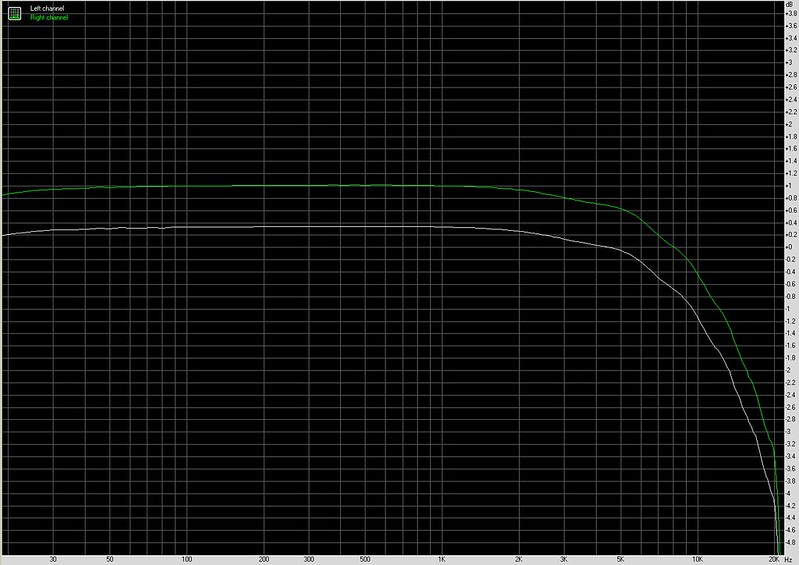
Unique Melody Merlin (5 driver 1 dynamic, 4 BA, 12Ω)
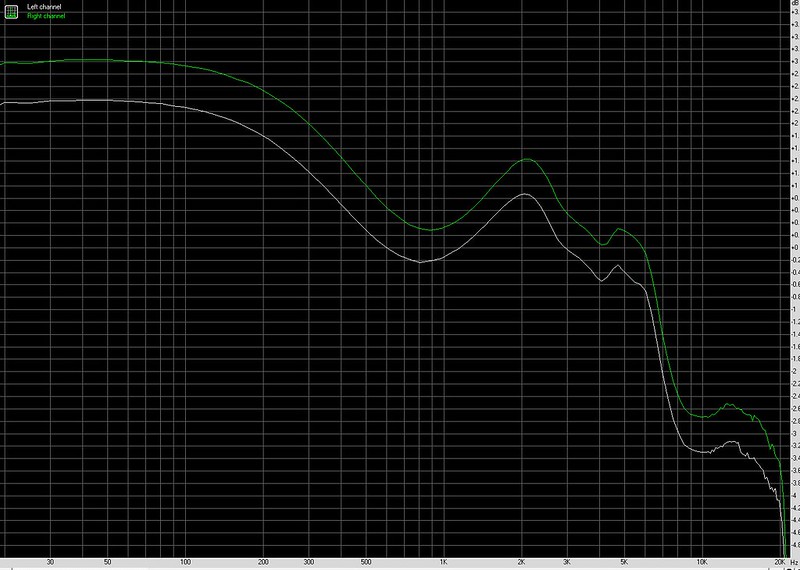
HiFiMan 801 (v2 amp module, I believe)
Alright, we all know how this is going to go, but for some reason I really like this absurdly terrible "Hifi" player. It's mainly that it looks like a casette player while actually being an MP3 player which, with Rockbox, is actually not that bad if I'm listening with my Grados (not just FR gets destroyed with my Unique Melody Merlins, but I get buzzes, pops, etc to the point where they're complete trash with this thing). Plus, there are only so many devices with full color displays that run Rockbox. Sure, the best would be an iPod, but that's just so mainstream, and way less absurd, so I haven't brought myself to sell this thing, even though I probably should. Anyway, here we go:
Unloaded:

Unique Melody Merlin (5 driver 1 dynamic, 4 BA, 12Ω)

Last edited:
hakuzen
Headphoneus Supremus
- Joined
- Feb 9, 2016
- Posts
- 1,807
- Likes
- 2,684
ouch, ouch.. that hurts..Well, my Merlins are finally fixed after having been stepped on a couple years ago, and I just never got around to having them reshelled. Well, I have, so I can do some measurements again.
HiFiMan 801 (v2 amp module, I believe)
Alright, we all know how this is going to go, but for some reason I really like this absurdly terrible "Hifi" player. It's mainly that it looks like a casette player while actually being an MP3 player which, with Rockbox, is actually not that bad if I'm listening with my Grados (not just FR gets destroyed with my Unique Melody Merlins, but I get buzzes, pops, etc to the point where they're complete trash with this thing). Plus, there are only so many devices with full color displays that run Rockbox. Sure, the best would be an iPod, but that's just so mainstream, and way less absurd, so I haven't brought myself to sell this thing, even though I probably should. Anyway, here we go:
Unloaded:

Unique Melody Merlin (5 driver 1 dynamic, 4 BA, 12Ω)

SilverEars
Headphoneus Supremus
- Joined
- Sep 18, 2013
- Posts
- 15,824
- Likes
- 7,325
@yuriv That $6 Sony MH755 does appear to have a good tonal response. Is that a stock response, no modification?
SilverEars
Headphoneus Supremus
- Joined
- Sep 18, 2013
- Posts
- 15,824
- Likes
- 7,325
This is great. I was curious how the transducer responds to EQ, and how much on the EQ itself.
yuriv
100+ Head-Fier
- Joined
- Apr 30, 2008
- Posts
- 156
- Likes
- 270
@yuriv That $6 Sony MH755 does appear to have a good tonal response. Is that a stock response, no modification?
A bit off topic, so
That frequency response is for the stock IEM. I got a good, consistent batch from e-bay well over a year ago:

Frequency response of 3 pairs of Sony MH755
I got lucky then. Here’s one time where the seller had the words “genuine product, not a fake” on the page, but look at what I got:
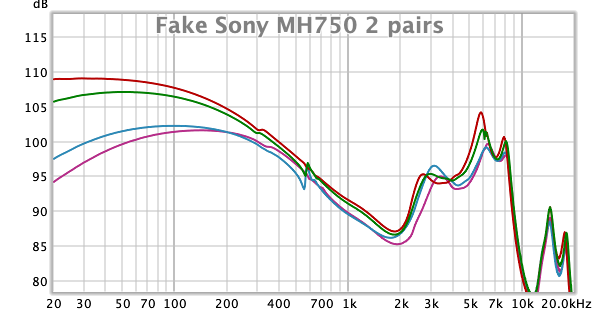
Frequency response of 2 pairs of fake Sony MH750
As you can imagine, they sounded really terrible. I returned them right away. I sensed that the seller wanted to argue with me, but once he saw the graph, he shut up.
Every once in a while, the MH750 pop up at Amazon. The ones I got from there should be genuine, but there is some variation between products. Here’s an MH750 with more bass than the three MH755 measured earlier:

Frequency response of Sony MH750 bought from Amazon seller
This pair and another one in the batch sometimes made a crinkling sound during insertion, Some extra care was needed to make sure the diaphragm didn’t bottom out. They’re likely not properly vented. Speakerphone/Clarityfidelity measured an MH755 and it comes closest to this one. I still think a properly working unit should behave like the three pairs of MH755 in the first graph above.
This means that a good pair will have less bass than the Sony MH1. I have a few of those and they're just too bassy for me, like +10 dB at 100 Hz, relative to 1 kHz. The good MH755 are only +5 dB at 100 Hz, and only +2.5 dB, relative to the response at 1 kHz, which is still a little too much bass for my tastes. Blocking the rear vent and sealing the base of the stem and the rear cup’s seam will decrease the compliance of the air volume behind the diaphragm. It’s not much of a bass reduction, but it sounds noticeably better to me:

MH755 frequency response with rear cup sealed. 2017 Harman In-Ear target shown in green.

MH755 frequency response with rear cup sealed, 2017 Harman In-Ear target compensated.
I suppose, at only 6-8 bucks a pop, you could afford to take risks and order a bunch of them. If you get a properly working unit, it should sound pretty good, depending on how much bass your sample has. It responds well to EQ and can tolerate a boost around 12 kHz. Measured distortion is low, and is dominated by the 2nd harmonic, which is the least offensive kind.
To equalize it to approach the 2017 Harman In-Ear target, see my Radsone ES100 review (scroll to the bottom):


I hear the ES100 will get a parametric EQ in a future firmware update, so it can get even closer to target. I prefer less bass than the target, but that's ok. So do the Harman researchers themselves.
Really, the Sony MH755 puts many expensive IEMs to shame. I prefer the sound of a stock MH755 to all of the cheaper (< $50) Chi-Fi IEMs being bandied around here, even crazy multi-driver arrangements. The ones I've heard, at least. Maybe we can all get Massdrop to reissue these things (as the MH75X or something like that) for around $10, instead of this:

$10 Massdrop HiFiMan Bolt, frequency response
If they did, it would set the community's expectation of what a cheap single-driver IEM ought to sound like, and at the same time call out the many pretenders out there.
Lol. I ended up writing more than a quick reply. I really should turn this post into a review.

Frequency response of 3 pairs of Sony MH755
I got lucky then. Here’s one time where the seller had the words “genuine product, not a fake” on the page, but look at what I got:

Frequency response of 2 pairs of fake Sony MH750
As you can imagine, they sounded really terrible. I returned them right away. I sensed that the seller wanted to argue with me, but once he saw the graph, he shut up.
Every once in a while, the MH750 pop up at Amazon. The ones I got from there should be genuine, but there is some variation between products. Here’s an MH750 with more bass than the three MH755 measured earlier:

Frequency response of Sony MH750 bought from Amazon seller
This pair and another one in the batch sometimes made a crinkling sound during insertion, Some extra care was needed to make sure the diaphragm didn’t bottom out. They’re likely not properly vented. Speakerphone/Clarityfidelity measured an MH755 and it comes closest to this one. I still think a properly working unit should behave like the three pairs of MH755 in the first graph above.
This means that a good pair will have less bass than the Sony MH1. I have a few of those and they're just too bassy for me, like +10 dB at 100 Hz, relative to 1 kHz. The good MH755 are only +5 dB at 100 Hz, and only +2.5 dB, relative to the response at 1 kHz, which is still a little too much bass for my tastes. Blocking the rear vent and sealing the base of the stem and the rear cup’s seam will decrease the compliance of the air volume behind the diaphragm. It’s not much of a bass reduction, but it sounds noticeably better to me:

MH755 frequency response with rear cup sealed. 2017 Harman In-Ear target shown in green.

MH755 frequency response with rear cup sealed, 2017 Harman In-Ear target compensated.
I suppose, at only 6-8 bucks a pop, you could afford to take risks and order a bunch of them. If you get a properly working unit, it should sound pretty good, depending on how much bass your sample has. It responds well to EQ and can tolerate a boost around 12 kHz. Measured distortion is low, and is dominated by the 2nd harmonic, which is the least offensive kind.
To equalize it to approach the 2017 Harman In-Ear target, see my Radsone ES100 review (scroll to the bottom):


I hear the ES100 will get a parametric EQ in a future firmware update, so it can get even closer to target. I prefer less bass than the target, but that's ok. So do the Harman researchers themselves.
Really, the Sony MH755 puts many expensive IEMs to shame. I prefer the sound of a stock MH755 to all of the cheaper (< $50) Chi-Fi IEMs being bandied around here, even crazy multi-driver arrangements. The ones I've heard, at least. Maybe we can all get Massdrop to reissue these things (as the MH75X or something like that) for around $10, instead of this:

$10 Massdrop HiFiMan Bolt, frequency response
If they did, it would set the community's expectation of what a cheap single-driver IEM ought to sound like, and at the same time call out the many pretenders out there.
Lol. I ended up writing more than a quick reply. I really should turn this post into a review.
Last edited:
SilverEars
Headphoneus Supremus
- Joined
- Sep 18, 2013
- Posts
- 15,824
- Likes
- 7,325
You know @yuriv , I did ask if I would run into fake ones on another thread, and you answered it. Funny how things work. Interesting thing is the other guy thought it's too cheap to knock-off, and that wasn't the reason for the question. They can knock-off stuff for the brand (for recognition) as iems can be made dirt cheap.
It's so profound how the cheap Sony follows the Harman target so closely. It got to have been the intention and it shows the control in tuning. And the consistancy... Interesting.
I say part of innovation is to bring the price down with performance. That is what I respect, and it is what benefits others.
Keep showing us what you find interesting @yuriv !
It's so profound how the cheap Sony follows the Harman target so closely. It got to have been the intention and it shows the control in tuning. And the consistancy... Interesting.
I say part of innovation is to bring the price down with performance. That is what I respect, and it is what benefits others.
Keep showing us what you find interesting @yuriv !
Last edited:
Zishan Z2
Unloaded :

Loaded :

That's very bad, once I have swapped the OP amp for a 1622 and removed output caps and resistors I'll measure again.
Unloaded :

Loaded :

That's very bad, once I have swapped the OP amp for a 1622 and removed output caps and resistors I'll measure again.
Last edited:
Here's the Zishan Z2 with OPA1622 installed, output cap and resistor removed :

Still a strange dip at 1k but the stupid bass roll-off is much better, and trebles are fixed.
WARNING: extremely loud noise when turning off the zishan with this mod, can lead to IEM and/or ear damage. Unplug them before turning the device off.

Still a strange dip at 1k but the stupid bass roll-off is much better, and trebles are fixed.
WARNING: extremely loud noise when turning off the zishan with this mod, can lead to IEM and/or ear damage. Unplug them before turning the device off.
Last edited:
CK Moustache
100+ Head-Fier
Apple USB-C to Headphone Jack Adapter (A2155); used purely as a DAC
No Load:

Triple.Fi 10:
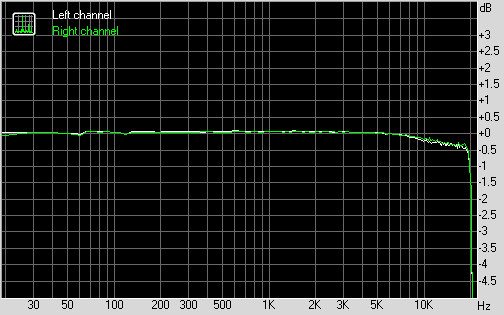
Overlay:

Knowledge Zenith AS10:

Calculated OI of 0.3 Ohms or less. Excellent.
Hiss performance (even with my extremely sensitive Campfire Audio Andromeda) excellent and quite close to absolute perfection as well (even outperforms my iBasso DX90 slightly in this regard).
No Load:

Triple.Fi 10:

Overlay:

Knowledge Zenith AS10:

Calculated OI of 0.3 Ohms or less. Excellent.
Hiss performance (even with my extremely sensitive Campfire Audio Andromeda) excellent and quite close to absolute perfection as well (even outperforms my iBasso DX90 slightly in this regard).
castleofargh
Sound Science Forum Moderator
- Joined
- Jul 2, 2011
- Posts
- 10,975
- Likes
- 6,813
I just understood you were @HiFiChris from seing a triple.fi ^_^
CK Moustache
100+ Head-Fier
https://www.head-fi.org/threads/956208/#post-16209940I just understood you were @HiFiChris from seing a triple.fi ^_^
CK Moustache
100+ Head-Fier
Sybasonic Byta
No Load:
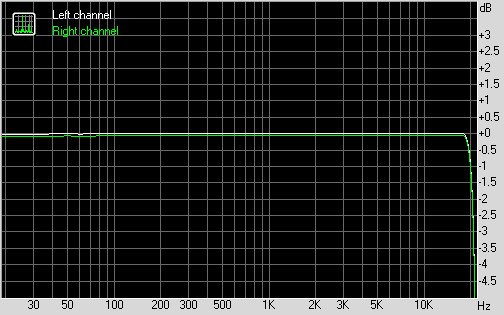
No Load; all of the four different EQ Modes; different Graph Scaling:
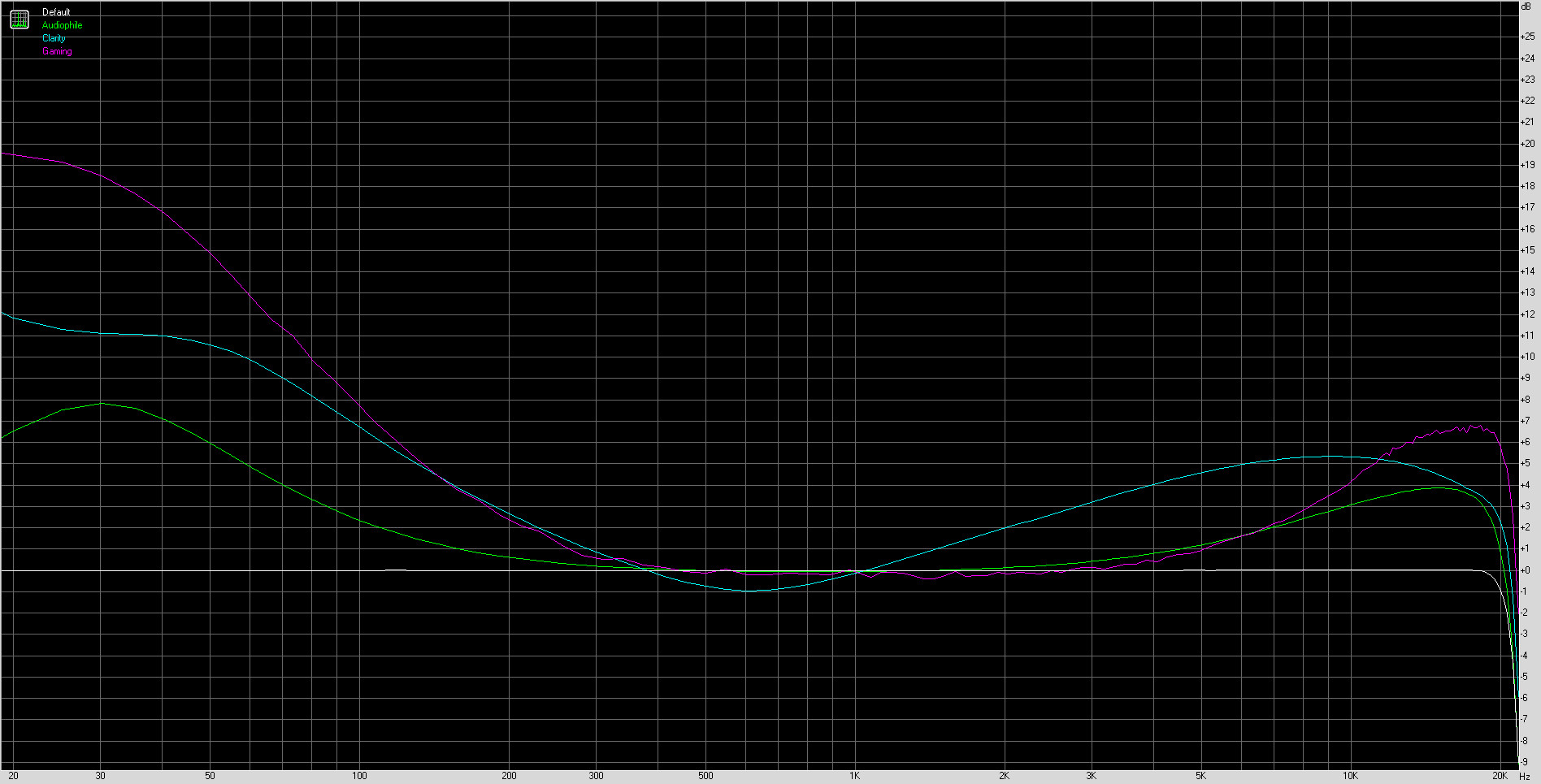
Triple.Fi 10:
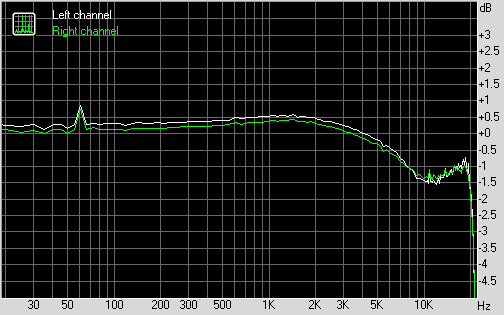
Calculated OI is around 2.4 Ohms.
(Please ignore the 60 Hz spike - if I recall correctly, I think it was caused by either the back-lit keyboard that was connected to my (wall power outlet driven with deactivated internal battery) measurement laptop computer or the ambient light strip's power supply that was connected to the same mains supply.)
Overlay:

Very poor hiss performance.
Already a bit of audible hiss with my Xiaomi Mi In-Ear Headphones Basic.
High to very high amount of hiss with my Ultimate Ears Triple.Fi 10.
Exorbitantly high amount of hiss with my extremely sensitive Campfire Audio Andromeda.
No Load:

No Load; all of the four different EQ Modes; different Graph Scaling:

Triple.Fi 10:

Calculated OI is around 2.4 Ohms.
(Please ignore the 60 Hz spike - if I recall correctly, I think it was caused by either the back-lit keyboard that was connected to my (wall power outlet driven with deactivated internal battery) measurement laptop computer or the ambient light strip's power supply that was connected to the same mains supply.)
Overlay:

Very poor hiss performance.
Already a bit of audible hiss with my Xiaomi Mi In-Ear Headphones Basic.
High to very high amount of hiss with my Ultimate Ears Triple.Fi 10.
Exorbitantly high amount of hiss with my extremely sensitive Campfire Audio Andromeda.
CK Moustache
100+ Head-Fier
FiiO M5
No Load:

Triple.Fi 10:

Excellent; OI even definitively below FiiO's already very good stated 0.5 Ohms.
Nearly perfect hiss performance even with my extremely sensitive Campfire Audio Andromeda.
Unfortunately other flaws that make it pretty much a useless device in combination with sensitive IEMs and in general: very often, there is some mild left channel crackle/pop when pausing/skipping/changing the playback position of most files and during the transition of two files (the latter mainly (although not exclusively) on lossy files, however the rest also happens very often (in almost all cases (click/pop/crackle is always present when changing the playback position or when pausing/resuming the playback/muting/unmuting the volume regardless of whether the file is lossy or lossless)) when playing lossless files), and it can even happen in a silent passage of a song; so it seems to be like some sort of totally unnecessary noise gate that immediately turns off the amplification section when no signal is detected is implemented.
No Load:

Triple.Fi 10:

Excellent; OI even definitively below FiiO's already very good stated 0.5 Ohms.
Nearly perfect hiss performance even with my extremely sensitive Campfire Audio Andromeda.
Unfortunately other flaws that make it pretty much a useless device in combination with sensitive IEMs and in general: very often, there is some mild left channel crackle/pop when pausing/skipping/changing the playback position of most files and during the transition of two files (the latter mainly (although not exclusively) on lossy files, however the rest also happens very often (in almost all cases (click/pop/crackle is always present when changing the playback position or when pausing/resuming the playback/muting/unmuting the volume regardless of whether the file is lossy or lossless)) when playing lossless files), and it can even happen in a silent passage of a song; so it seems to be like some sort of totally unnecessary noise gate that immediately turns off the amplification section when no signal is detected is implemented.
Users who are viewing this thread
Total: 2 (members: 0, guests: 2)























